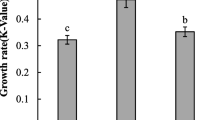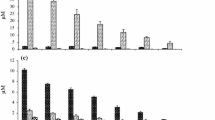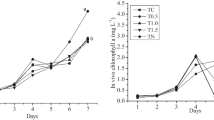Abstract
The effects of nitrate and silicate levels, and carbon source on growth, biochemical composition and fatty acid composition ofNitzschia inconspicua were investigated using batch cultures. Within the range of silicate levels supplied (8.8–176 μM), no marked variations in growth trend, biochemical composition or fatty acid composition were shown. Biomass at stationary phase, ranging from 64–66 mg ash-free dry weight (AFDW) L−1, and specific growth rate (μ) based on chlorophylla (0.41–0.50 d−1) of the cultures grown within 0.3–3.0 mM NaNO3 were not significantly different. Cultures supplemented with glucose (0.1 % w/v), acetate (0.1 % w/v) or 5% CO2 attained higher biomass (85, 85, 97 mg AFDW L−1) than the control which was grown in synthetic seawater and agitated by magnetic stirring. Cells grown at <3.0 mM NaNO3 contained higher carbohydrate contents (14.8–21.5% AFDW) than those grown at 3.0 mM (4.0% AFDW). Lipid content increased at the expense of proteins in cells aerated with 5% CO2. The dominant fatty acids, 16:0 and 16:1, ranged from 35.7–45.0% and 36.4–45.4% total fatty acids (TFA), respectively, while the relative proportions of 20:4 (n-6) and 20:5 (n-3) ranged from 1.7–5.4% and 3.4–5.9% TFA respectively. Cultures aerated with 5% CO2 attained the highest biomass (97 mg AFDW L−1) and yield of 20:5 (n-3) (0.34 mg L−1).
Similar content being viewed by others
References
Bligh EG, Dyer WJ (1959) A rapid method of total lipid extraction and purification. Can. J. Biochem. Physiol. 37: 911–917.
Bradford MM (1976) A rapid and sensitive method for the quantitation of microgram quantities of protein utilizing the principle of protein-dye binding. Analyt. Biochem. 72: 248–254.
Chrismadha T, Borowitzka MA (1994) Effect of cell density and irradiance on growth, proximate composition and eicosapenatenoic acid production ofPhaeodactylum tricornutum grown in a tubular photobioreactor. J. appl. Phycol. 6: 67–74.
Christie WW (1989) Gas Chromatography and Lipids. The Oily Press, Scotland: 69–70.
Chu WL, Phang SM, Goh SH (1994) Studies on the production of useful chemicals, especially fatty acids in the marine diatomNitzschia conspicua Grunow. Hydrobiologia 285: 33–40.
De Pauw N, Persoone G (1988) Micro-algae for aquaculture. In Borowitzka MA, Borowitzka LJ(eds), Micro-algal Biotechnology. Cambridge University Press, Cambridge: 257–287.
Dortch Q (1982) Effect of growth conditions on accumulation of internal nitrate, ammonium, amino acids, and protein in three marine diatoms. J. exp. mar. Biol. Ecol. 61: 243–264.
Dunstan GA, Volkman JK, Barett SM, Garland CD (1993) Changes in the lipid composition and maximisation of the polyunsaturated fatty acid content of three microalgae grown in mass culture. J. appl. Phycol. 5: 71–83.
Kochert AG (1978) Carbohydrate determination by the phenolsulphuric acid method. In Hellebust JA, Craigie JS(eds), Handbook of Phycological Methods — Physiological and Biochemical Methods. Cambridge University Press, Cambridge: 95–97.
Kyle D, Behrens P, Bingham S, Arnett K, Lieberman D (1988) Microalgae as a source of EPA-containing oils. In Applewhite TH(ed.) Proc. World Conf. Biotech. for Fats and Oils Industry. Am. Oil Chemists' Soc., Champaign, Illinois: 117–121.
Lewin JC, Hellebust JA (1976) Heterotrophic nutrition of the marine pennate diatomNitzschia angularis var.affinis. Mar. Biol. 36: 313–320.
Nalewajko C (1966) Dry weight, ash, and volume data for some freshwater planktonic algae. J. Fish. Res. Bd Can. 23: 1285–1288.
Orcutt DM, Patterson GW (1975) Sterol, fatty acid and elemental composition of diatoms grown in chemically defined media. Comp. Biochem. Phyciol. 50B: 579–583.
Renaud SM, Parry DL (1994) Microalgae for use in tropical aquaculture II: Effect of salinity on growth, gross chemical composition and fatty acid composition of three species of marine microalgae. J. appl. Phycol. 6: 347–356.
Renaud SM, Parry DL, Thinh LV (1994) Microalgae for use in tropical aquaculture I: Gross chemical and fatty acid composition of twelve species of microalgae from the Northern Territory, Australia. J. appl. Phycol. 6: 337–345.
Roessler PG (1988) Changes in the activities of various lipid and carbohydrate biosynthetic enzymes in the diatomCyclotella cryptica in response to silicon deficiency. Arch. Biochem. Biophys. 267: 521–528.
Shamsudin L (1992) Lipid and fatty acid composition of microalgae used in Malaysian aquaculture as live food for the early stage of penaeid larvae. J. appl. Phycol. 4: 371–378.
Shifrin NS, Chisholm SW (1980) Phytoplankton lipids: environmental influences on production and possible commercial applications. In: Shelef G & Soeder CJ (eds) Algae Biomass: Production and Use. Elsevier/North Holland Biomedical Press, Amsterdam: 627–645.
Strickland JDH, Parsons TR (1968) A practical handbook of seawater analysis. Bull. Fish. Res. Bd Can. 167: 311.
Taguchi S, Hirata JA, Lawa EA (1987) Silicate deficiency and lipid synthesis of marine diatoms. J. Phycol. 23: 260–267.
Tan CK, Johns MR (1994) Eicosapentaenoic acid production by heterotrophicNitzschia laevis in chemostat cultures. In Phang SM, Lee YK, Borowitzka MA, Whitton BA(eds), Proceeding of the First Pacific Conference on Algal Biotechnology, University of Malaya, Kuala Lumpur: 33–38.
Yongmanitchai W, Ward OP (1991) Growth and omega-3 fatty acid production byPhaeodactylum tricornutum under different culture conditions. Appl. Envir. Microbiol. 57: 419–425.
Author information
Authors and Affiliations
Rights and permissions
About this article
Cite this article
Chu, WL., Phang, SM. & Goh, SH. Environmental effects on growth and biochemical composition ofNitzschia inconspicua Grunow. J Appl Phycol 8, 389–396 (1996). https://doi.org/10.1007/BF02178582
Received:
Revised:
Accepted:
Issue Date:
DOI: https://doi.org/10.1007/BF02178582




